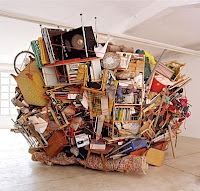After creating a series of 40 ornament-size replicas of inanimate household objects, I was left not really knowing what to do with them. After deliberating about which direction I would like this project to head in, I decided on animation. Having dabbled in some animation in the past I am not completely staring from scratch, yet I do have a lot to learn. I will begin my making a series of short tests. My aim at this point is to experiment with making my objects 'come alive', in their own setting - my house.
I need to...
- Rethink and rewrite my brief, update any changes to the project
- Re-research, get back into the library and find new information to keep this thing moving along
- Experiment/test more, try not to get stuck in one way of working again
- Read Plato - Maddie's suggestion
- Work on concept and content and context first and foremost
- Have more fun in the process, not getting bogged down worrying about "seriousness" of project, it isn't a project with a really serious theme, it is more celebratory and light hearted, try to make work that displays this mood.
- Think about what really interests me, and what will give me the most satisfaction from completing this project
Things I want to develop on from last semester...
I have these objects now, and I would like to experiment with using them in an interesting way instead of chucking that idea out and starting on something completely different. making a stop motion animation will be my first test. The idea from "Objects of our Desires" about how children believe inanimate objects have feelings could be a theme for the video, personifying objects. The objects almost resemble chess peices, or game tokens, and I am interested in pastimes such as gaming. So putting these objects into a gaming context may be a good way to give the work more meaning, and create more interest in it for me.
Individual Contract Semester 2
Jessica Kidd
05136261 AimThis semester I will continue on with my investigations surrounding inanimate objects. I aim to work with video this semester, as I haven’t all year so far and I am missing it. I would like to make a stop motion, using my objects from last semester as a starter and then moving on to perhaps working with the real objects from my house. This project will be a way to investigate the history of the stop motion film and its relevance today, when most animated films are made with computers, not good old-fashioned stop motion. I also aim to make humorous work, so it will be an opportunity to learn about what humour means to the art world.
Method-Begin by making a stop motion using my clay objects from last semester
-Learn how to use the DVX100 camera properly, I have been taught in the past but have never really had the chance to use it on my own until now
-Research humour and stop motion for starters
-Think about the use of the real objects instead of clay. What will this change? Why would I use the clay ones anyway? That doesn’t make sense to me.
-Think about what it will take to animate inanimate objects, putting faces on them? If so what will this be made from?
-Find out how to do stop motion facial expressions/ stop motion in general.
-Also have to consider the hallucinogenic implications of household objects coming to life.
-I am interested in leisure at the moment, what people choose to do with their spare time, so research leisure.
Read
- Plato, Platonic Forms
- Research into history/theory of stop motion
- Research Leisure Studies
People to look at
-Tony Oursler
- Sean Kerr
- Jan Svankmayer
- Bollex Brothers
Things to look at
- The Brave Little Toaster
- Fantasia
- H R Pufnstuf























